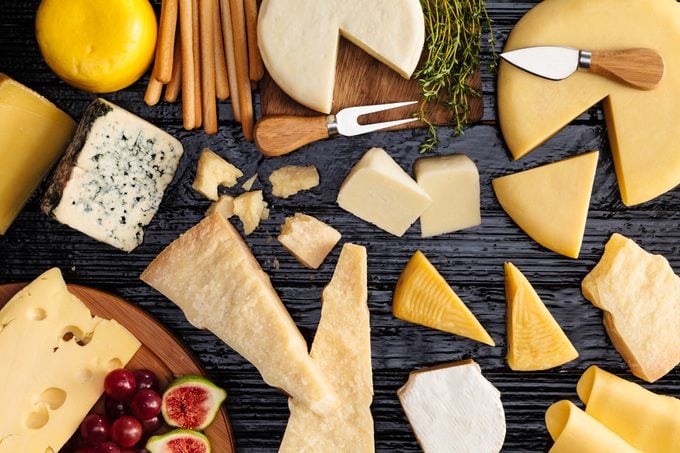Can People With Diabetes Eat Cheese?
Updated: Jan. 18, 2023
If you have type 2 diabetes, it's fine to eat cheese—although some types are better than others. Cheese may even help you manage your weight and blood sugar, but keep calories and portion sizes in mind.
Nutrition experts can be a fickle group when it comes to dairy and diabetes, giving various products a thumbs up or down, depending on the mood and moment. But cheese is a remarkably diabetes-friendly food.
“It has basically no—or very little—carbohydrate, so it won’t have much impact on blood sugar,” says Melinda Maryniuk, RDN, a certified diabetes care and education specialist, and owner of Diabetes & Nutrition Consultants in Boston. “It contains protein and fat, which help keep you feeling full until the next meal, and keep your blood sugar steady. Cheese is also a great source of other nutrients such as calcium, vitamin A, B12, and zinc.”

The skinny on saturated fat
That doesn’t mean you can load up on all the mac ‘n’ cheese you want. Cheese is packed with calories. It’s also a significant source of saturated fat and sodium, both of which raise your risk for cardiovascular disease—something people with diabetes are already at risk for.
“Diets high in fat, especially saturated fat, have long been thought to contribute to cardiac risk and other disorders,” says Marlisa Brown, RDN, a spokesperson for the Association of Diabetes Care and Education Specialists.
But research, including a review of studies published in 2018 in the journal Foods, suggests saturated fat isn’t entirely a nutritional no-no. Milk, it turns out, has a neutral effect on cardiovascular health. And fermented dairy products, such as yogurt, kefir, and cheese may have a positive effect.
“This may be due to the bioactive peptides of fermented dairy products on improved insulin sensitivity and improved (post-meal) insulin response,” says Dahlia Gomez, RD, a San Antonio-based spokesperson for the Association of Diabetes Care and Education Specialists.
That’s not to suggest you can eat unlimited amounts. You still have to practice portion control. “The latest Dietary Guidelines for Americans advises less than 10 percent from saturated fat, which is about 22 grams per day based on a 2,000-calorie diet,” says Gomez.
It’s also good to note that meals that are high in fat, including meals that contain cheese such as lasagna, pizza, and spaghetti, can slow down the digestion of carbohydrates and make glucose rise much later than if eating the same amount of carbohydrates without the fat.
Considering calories
The guidelines also recommend choosing fat-free or low-fat dairy. For cheese lovers, lower-calorie options include goat cheese, parmesan, feta, Neufchatel, part-skim mozzarella, and skim ricotta.
Keep in mind: Calorie counts range from about 72 calories per serving for part-skim mozzarella to about 130 calories per serving for Parmesan. When you use a hard cheese like cheddar, eat less of it or choose a low-fat version. You probably won’t want to snack on low-fat cheddar, though, so experiment with other options, such as goat cheese.
Try goat cheese sprinkled with herbs and drizzled with lemon juice (the acid can help lower blood sugar). Plus, goat cheese contains the protein A2 casein, which may be less inflammatory and easier on the digestive system than the A1 casein found in cow’s milk, according to a study published in 2017 in Nutrition Journal.
Adding cheese to your diet
Including cheese in your eating plan is a diabetes-friendly way to make sure your overall nutritional needs are being met. “Many Americans aren’t meeting their dietary reference intakes of several essential nutrients, including calcium, vitamin D, and potassium,” says Gomez. “These are found in dairy products.”
Keep in mind: A serving of cheese is a scant 1 ounce (30 grams). That’s “about the size of two dice cubes or a small matchbox,” says Maryniuk. “Adding even a little cheese can help reduce the glycemic impact of the original food.”
Here are some tasty ways to get cheesy:
- Stir in shredded mozzarella to whole wheat noodles.
- Add feta or goat cheese to an omelet.
- Serve cheese and fruit as an appetizer, snack, or dessert. Try cheddar with sliced apples, Brie with pears, shaved Parmesan with Asian pears, or cottage cheese with fresh peaches.
- Make shredded Swiss cheese the star of your salad. Add diced seedless grapes, pecans, and chopped fresh basil.
- Top cottage cheese with fruit for a light meal or snack or half an avocado for brunch.
- Add crumbled goat cheese to salads and pizzas. Use whipped goat cheese in dips.
- Make a toaster-oven pizza by topping whole wheat pita with tomato sauce, mozzarella, and whatever veggies you have on hand.
- Skip processed cheese products or any “cheese that comes in a can, jar or lasts on the shelf without a refrigerator,” says Gomez. “Instead, stick with mozzarella, swiss, or cheddar cheeses.”




